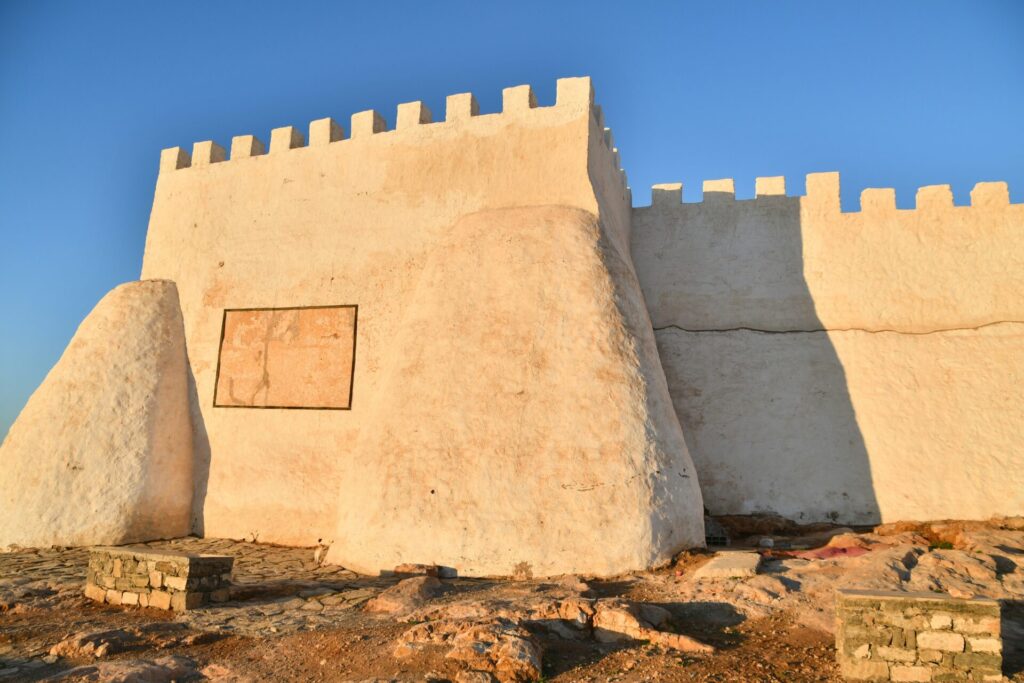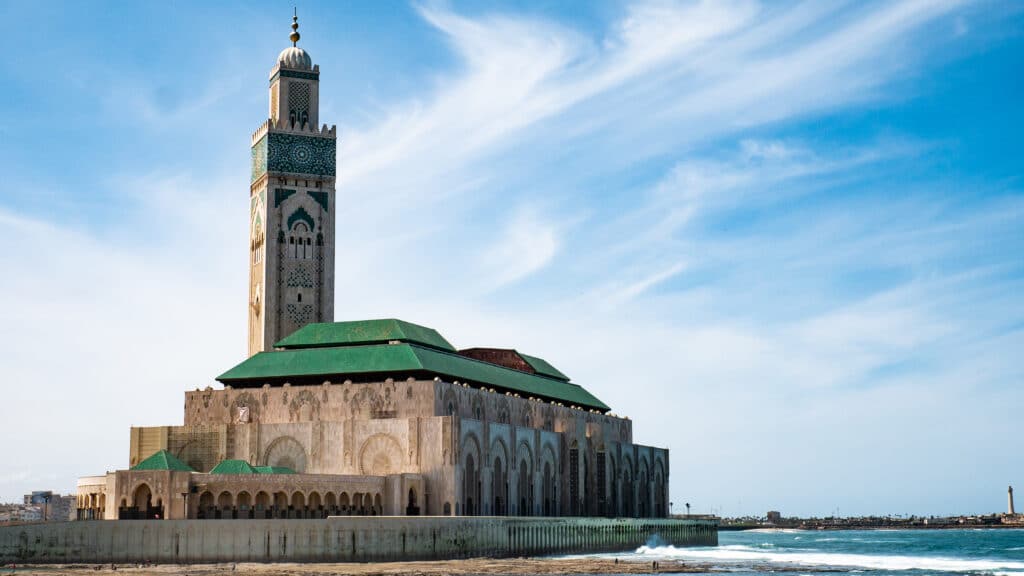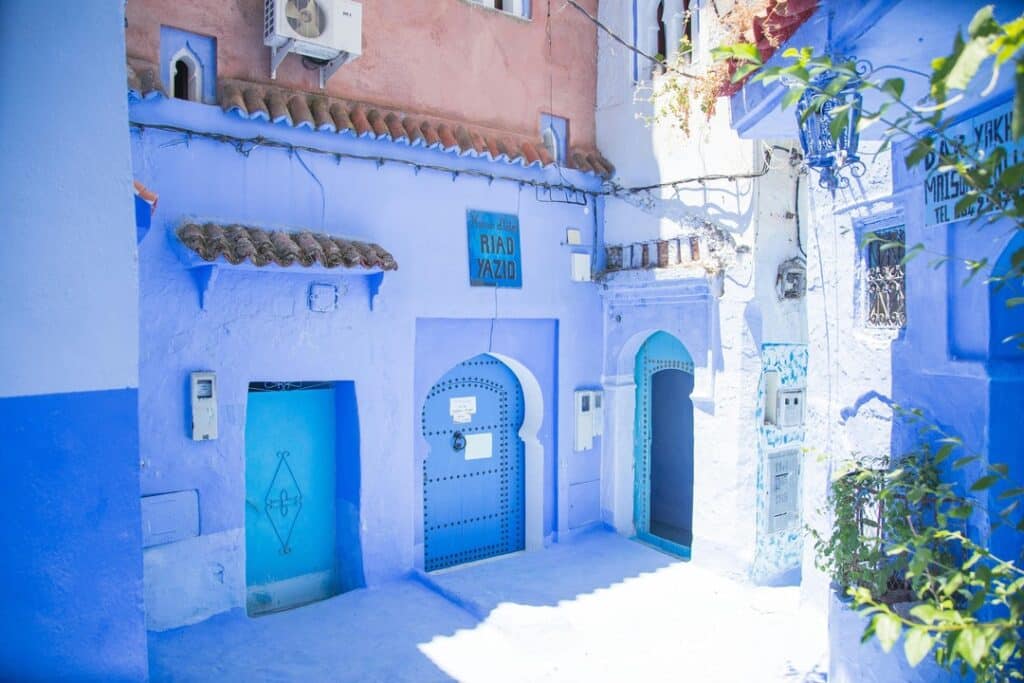This 11-day tour from Agadir covers Morocco’s full range of landscapes and cultures. Start in Agadir, then travel to Essaouira for coastal heritage. Continue to Marrakech for a guided tour of monuments, palaces, and souks.
Head north to Casablanca for the Hassan II Mosque, then to Rabat for its Islamic and colonial landmarks. Visit Chefchaouen in the Rif Mountains, then continue via Volubilis and Meknes to Fes for its ancient medina.
Cross the Middle Atlas to reach Merzouga in the Sahara. Ride camels in Erg Chebbi and camp overnight. Visit Todra Gorges and Dades Valley. Return to Agadir via Ouarzazate and Ait Ben Haddou (UNESCO site).
Tour includes private transport, local guides, selected meals, and overnight stays in riads, hotels, and a desert camp.











Arrive at Agadir Airport. A representative will meet you and transfer you to your hotel in the city. Agadir, located on Morocco’s southern Atlantic coast, is a modern beach resort rebuilt after a 1960 earthquake.
After check-in, the rest of the day is free. Depending on your arrival time, you can walk the 10 km Agadir Beach or explore the Marina d’Agadir, a harbor area with shops, restaurants, and cafes.
For cultural insight, visit Souk El Had, one of Morocco’s largest markets, selling fresh produce, spices, and traditional crafts. For a panoramic view, head to the Agadir Kasbah ruins on the hill best visited at sunset.
Dinner is on your own, with options for seafood or Moroccan cuisine; your guide can suggest restaurants. Return to the hotel for the night.
After breakfast at the hotel, continue exploring Agadir with your guide. Possible stops include:
Late morning, depart north toward Essaouira. The 175 km drive (~3 hours) follows the Atlantic coast, with scenic viewpoints for photo stops.
En route, pass through argan tree forests. Stop at a women-run argan oil cooperative to see traditional oil extraction for culinary and cosmetic use. Optional purchase of products on site.
Arrive in Essaouira in the afternoon. Check into your riad. After a break, take an orientation walk with your guide.
Essaouira (formerly Mogador) reflects Portuguese, French, and Berber influences in its architecture and culture. Explore the UNESCO-listed medina, known for blue-white buildings and preserved ramparts. The medina layout is simpler than other Moroccan cities.
Dinner at a seafood restaurant near the port select fresh fish for grilling on-site. Your guide can recommend places based on your taste. Optional evening beach or rampart walk before returning to the Riad/hotel.
Use your free time for a final walk in Essaouira or to shop for last-minute items in the medina. Late morning, meet your driver and begin the 195 km drive (~2 hours 45 minutes) inland to Marrakech.
The route transitions from coastal plains to farmland and low hills. Pass through argan forests watch for goats climbing trees to eat the fruit. Optional stop at an argan oil cooperative to learn more or purchase products.
As you near Marrakech, the High Atlas Mountains come into view, and the red earth characteristic of “The Red City” becomes prominent. Arrive in the afternoon and check into your riad or hotel near the medina.
After settling in, the rest of the day is free. Consider a first visit to Jemaa el-Fnaa, a UNESCO cultural site and central square filled with performers, food vendors, and markets. Activity intensifies in the evening with storytellers, musicians, and outdoor dining.
Explore nearby souks or main shopping streets radiating from the square. Marrakech’s medina is larger and more complex than Essaouira’s expect a maze of alleys and bustling commerce.
For dinner, choose between a traditional meal at your riad, dining at a medina restaurant, or sampling food stalls at Jemaa el-Fnaa. Your guide can suggest options based on your preferences. Return to your accommodation to rest ahead of tomorrow’s city tour.
Meet your local guide for a full-day (or Half-day) tour of Marrakech, one of Morocco’s four imperial cities.
Begin at the Koutoubia Mosque its 77 m minaret, dating to the 12th century, is a city landmark (non-Muslims can view only the exterior and gardens). Continue to the Saadian Tombs, rediscovered in 1917, showcasing royal burials with colorful tiles and carvings.
Visit the Bahia Palace, a 19th-century residence with ornate woodwork, painted ceilings, and courtyards. Then explore the ruins of El Badi Palace, once a Saadian showpiece its vast layout and sunken gardens remain impressive.
Enter the medina’s souks, where your guide will help navigate the alleys and explain local crafts. Shops feature spices, leather, textiles, and metalwork. Pause for lunch at a traditional restaurant in the medina; your guide can suggest local tagine or couscous spots.
In the afternoon, visit the Majorelle Garden, with exotic plants and vivid blue buildings formerly owned by Yves Saint Laurent. Inside is the Berber Museum, focusing on indigenous Moroccan culture. Optionally, continue to the Menara Gardens, known for a reflecting pool and Atlas Mountain views.
Return to Jemaa el-Fnaa to witness its evening transformation food vendors, performers, and musicians fill the square. After the tour, enjoy free time to explore or relax.
Optional evening activity: traditional Moroccan hammam and spa (extra cost). Dinner options include food stalls at Jemaa el-Fnaa or a restaurant your guide can advise based on preferences.
Begin the 327 km journey north to Rabat with a key stop in Casablanca. The first leg Marrakech to Casablanca covers 240 km in ~2.5 hours through countryside.
In Casablanca, visit the Hassan II Mosque, one of the largest in the world and the only Moroccan mosque open to non-Muslims (with guided tour, entrance fee not included). Built partially over the Atlantic, it holds 25,000 worshippers indoors and 80,000 in the courtyard. Features include a retractable cedar roof, 78 granite columns, zellige tilework, and a glass floor above the ocean.
Optionally, drive along Casablanca’s Corniche, a modern seaside district with restaurants, clubs, and hotels. Lunch in Casablanca choose from seafood or Moroccan cuisine (guide can recommend spots).
Continue to Rabat in the afternoon (87 km, ~1 hr 15 min drive). On arrival, check into your hotel or riad and begin sightseeing:
Evening options: stroll Mohammed V Avenue (colonial-era administrative buildings) or explore the medina. Dinner at a local restaurant try seafood pastilla or classic Moroccan dishes (guide can advise).
Begin the 254 km (~4-hour) drive northeast to Chefchaouen. The route starts along the Atlantic coast, then turns inland through rolling hills into the Rif Mountains.
Stop en route for rest, photos, and optional refreshments. Your guide will provide context on the regions and Moroccan culture along the way.
Arrive in Chefchaouen in the afternoon and check into your riad near the medina. After a break, take a guided walking tour through the town’s blue-painted streets. Founded in 1471 as a fortress against Portuguese incursions, Chefchaouen gained its iconic blue hues in the 1930s from Jewish refugees.
Key sites include:
Explore local shops known for wool garments and woven blankets. Chefchaouen offers a relaxed shopping environment compared to major cities.
Optionally, hike to the Spanish Mosque (built 1920s, unused) on a nearby hill. It offers a prime sunset view over the town.
Dinner at a local restaurant consider trying regional dishes featuring goat cheese or local variations of Moroccan cuisine. Your guide can recommend options. Afterward, stroll the medina under evening lights or relax at a café in the main square.
Enjoy free time for a final walk through Chefchaouen or to buy souvenirs. By mid-morning, check out and begin the 263 km journey to Fes, with stops at Volubilis and Meknes.
The first leg Chefchaouen to Volubilis takes ~3 hours (150 km), descending from the Rif Mountains through olive groves and farmland.
Stop at Volubilis, Morocco’s best-preserved Roman site and a UNESCO World Heritage site. Take a guided tour of mosaics, arches, villas, and public buildings dating back to the 3rd century BCE. The site was inhabited until the 18th century.
Continue 30 km (~30 minutes) to Meknes, a 17th-century imperial city. Break for lunch at a local restaurant (guide can recommend options). Then visit:
Late afternoon, drive ~1 hour (60 km) to Fes. Check into your riad in or near the historic medina. Optionally, take a short orientation walk with your guide to get familiar with Fes el Bali, the oldest part of the city with over 9,000 alleys.
Dinner options include eating at your riad or at a medina or Ville Nouvelle restaurant (guide will recommend). Rest well ahead of tomorrow’s Sahara-bound travel.
Depart Fes for a 470 km (~7 hrs 30 min with stops) journey to Merzouga, gateway to the Sahara.
Travel through the Middle Atlas Mountains, where the scenery shifts from plains to forested peaks. Stop in Ifrane, a French-built alpine-style town with clean streets and a lion statue at its center.
Continue south to Azrou’s cedar forest, habitat of the Barbary macaques. Pause to observe and optionally feed the monkeys.
Proceed to Midelt, a town between the Middle and High Atlas ranges known for apples and minerals. Lunch at a local restaurant your guide can suggest Berber cuisine options.
After lunch, pass through the Ziz Valley, with palm-filled oases and views of changing terrain. As you near Erfoud, the landscape becomes arid. Erfoud is known for fossils and date production.
Reach Merzouga in the late afternoon. Rest briefly at a hotel near the dunes, then mount camels for a ~1-hour sunset trek into the Erg Chebbi dunes.
Arrive at your desert camp before sunset. Climb a nearby dune for panoramic views as the sand shifts in color. Afterward, settle into your tent and have dinner indoors or under the stars, weather permitting.
Gather around the campfire for live Berber music performed by local staff. End the evening with stargazing ideal conditions far from light pollution. Camp tents include beds and shared bathrooms; some offer the option to sleep under the stars.
Wake early to watch the sunrise over the Sahara dunes, then return to camp for breakfast. Afterward, mount camels returned to Merzouga. Freshen up at a local hotel before beginning the 276 km (~4 hrs 30 min with stops) westbound journey.
First stop: Rissani, former capital of Tafilalet and birthplace of Morocco’s ruling Alaouite dynasty. If visiting on a market day (Tue, Thu, Sun), explore the traditional souk a non-touristy market selling spices, goods, and livestock.
Continue to Erfoud, known for fossils. Optional stop at a fossil workshop to see prehistoric marine fossils (350–500 million years old) crafted into decor and furniture.
Next, drive to Todra Gorges towering limestone canyons reaching 300 m high and narrowing to just 10 m in places. Walk the riverbed trail, observe rock climbers, and browse local stalls or cafes near the gorge entrance.
Optionally, visit a nomad family in mountain caves, share mint tea, and learn about their way of life.
In the afternoon, drive through the Dades Valley, known for unusual rock formations called “monkey fingers” and fortified kasbahs. Stop at a viewpoint overlooking the Dades Gorges and its serpentine road one of Morocco’s most photographed spots.
Arrive in Boumalne Dades, check in to your hotel with valley views. Dinner includes local produce and traditional Moroccan dishes. Optional evening terrace time for star-watching and relaxation.
After breakfast, begin the 517 km (~7 hrs 30 min with stops) journey from the Dades Valley to Agadir, crossing varied landscapes and cultural landmarks.
First, drive 110 km (~2 hrs) to Ouarzazate, known as the “Hollywood of Africa.” Optional stops:
Next, detour to the Ait Ben Haddou Kasbah, a UNESCO-listed fortified village used in numerous films. Walk its narrow streets and climb for panoramic views. Learn about its caravan-trade past with your guide.
After lunch near Ait Ben Haddou, continue west through Taznakht, known for Berber carpet weaving. Optionally visit a cooperative to see traditional techniques and purchase directly from artisans.
Then pass through Taliouine, Morocco’s saffron capital. If in season (Oct–Nov), witness the saffron harvest. Visit a saffron cooperative to learn about its cultivation and explore products like saffron teas, oils, and creams.
The final leg Taliouine to Agadir covers 220 km (~3 hrs) through the Anti-Atlas Mountains, descending to coastal plains. Arrive in Agadir in the evening and check in.
Dinner options: seafood near the port/beach or international cuisine (guide can recommend). Optional walk along the beachfront promenade.
Enjoy free time based on your departure schedule. Options include:
If time allows, optional visits:
At the scheduled time, transfer to Agadir Airport (25 km, ~30 min drive) for your departure.
From
per person